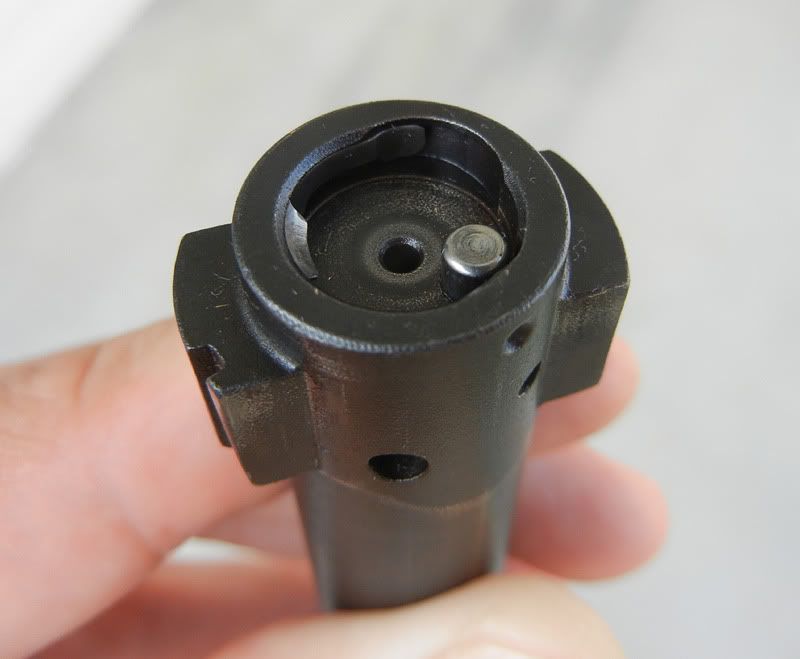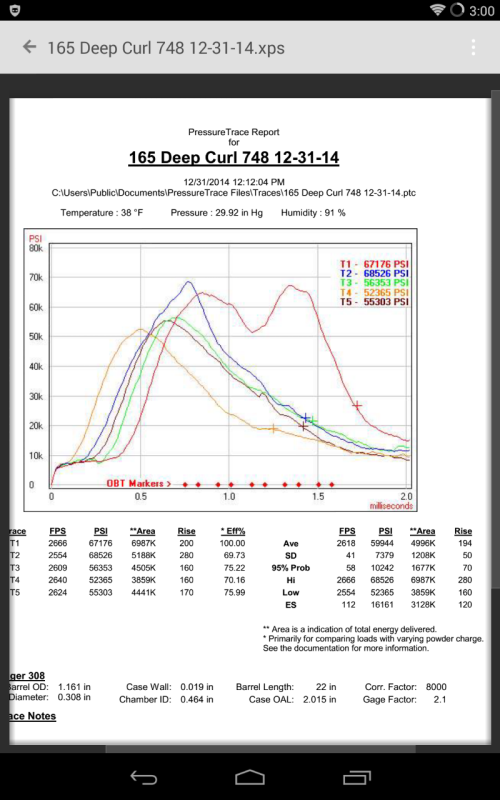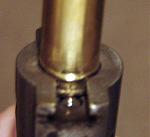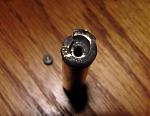I see e-swipe on one, primer looks good. How was bolt lift.
I've got e swipe on honady ammo, and black hills ammo years ago when I used to shoot factory ammo.
So you're good.


Reloading .308 Winchester using Lapua brass, 43.3 grains Varget powder with CCI BR primers and 175 gr SMK.
The rifle is a Savage 10 FCP-K with 24" barrel with the brake removed and using a AAC Cyclone suppressor.
I am shooting through a Caldwell chrony and my range in Colorado is about 6400ft in altitude.
I am curious if the fps that my chrony is giving me is too high for this particular load and do I need to back off the powder charge and retest for accuracy nodes. The Hodgdon manual says that 42 grains is the starting load and I read that you need to back off a few percentage points because of the Lapua brass so I ended up starting at 41.1. Also per the manual the max load is 45. The fps per the manual at max load is 2690 fps. I am getting consistently around 2730 fps using 43.3 grains with my rifle.
Does this sound ok considering the difference in load and I'm pretty sure Hodgdon did not test at my altitude? I had another accuracy node at 42.2 grains but it was better at the 43.3.


I see e-swipe on one, primer looks good. How was bolt lift.
I've got e swipe on honady ammo, and black hills ammo years ago when I used to shoot factory ammo.
So you're good.
Im betting more 308's than not love that load. You can exchange that with 4064 as well. Chive on,


If the round circle on the base of the case is a raised bump like a pimple, you have brass flow and high chamber pressure.
If the round ring is not a raised bump and just a ring, the hole in the ejector may have sharp edges and causing the ring. The ejector hole edges can be stoned and polished to remove the sharp edge and eliminate the rings on your cases.
The raised ring around the firing pin strike in the primer is caused by a oversized hole in the bolt face or a under size firing pin. This allows the primer to flow into the hole in the bolt face and you may need to have the bolt bushed to fix the problem.
Don't get too upset about the primer flow, I have a Remington 700 with a beveled firing pin hole and worse than your primer flow that Remington says is OK and will not fix it.

I've used your exact load before on that exact rifle. Never had any over pressure signs. Great load. Couldn't find varget anymore (at that time) so I went imr 4064 and never looked back.
Your good to go.


Am using 43.9 grains of varget with 178 ELD-X on my savage 10T. Getting 2720 fps avg. It's a bit hot but not to bad. Your just at the edge but not way over. If your groupings are good, leave it alone and keep an eye on your brass and primers.


I see an ejector mark on both cases. Typically an ejector mark on Lapua brass is really pushing it.
"As long as there's lead in the air....there's still hope.."


Below is a raised bump with brass flow into the ejector opening, the OPs photo just looks like a circular ring from the sharp edge around the ejector hole. Meaning a raised bur or edge around the ejector hole circumference and no brass flow. But it could be the lighting in the Ops photo not showing a raised bump.



Improperly sized brass (bumping the shoulders back too far) can cause marks like those pictured.
I wont work up heavy loads in brass that's not been fireformed to my chamber.
How many times has that brass been fired?
Re-arranged things to keep thoughts concentrated on a topic.
1) If you are over book velocity, you are over book pressure; end of story. Powder is not some mythical never varying thing. Notice the warning on the side of the bottle telling you that lot variation can be as much as 10%? There is a VERY real reason for that warning, I've personally pressure tested lots with over 12% variance. Remember that canister grade powder that we buy isn't made "for us", we are the waste market and always have been. Many times Hodgon will buy multiple lots of a powder with a general burning range and blend them to a product, slap on a label and off it goes. Powder also ages and gains or loses moisture and thus changes burning speed even from sealed containers. There are discussions about this in the now very old A-Squared manual, and the most recent Norma manual. Norma discusses and pressure tests this in that manual.
2) I read that Elvis is still alive and hanging out with 2-Pac and a Yeti; take both those stories for what they are.To know the difference, you need to measure it; but how that changes the burning rate isn't a fixed amount.
Most folks use the primers or headstamp as a pressure measurement tool, not good. At best it is a very very simiple indicator only. No one tells you what alloy or tensile strength their cases or primer cups are built to, since Olin in the 1950's. There are varying reports of amounts above SAAMI MAP that certain people build cases to, but nothing I've seen in print from the source. From my own pressure testing with the 308 and Creedmoor, I can tell you that the deformation that most people would think suspect; typically happens when you are near or above 75,000 psi. That was true with 3 different case makers. So if you see the typical "signs" does that let you know you hit SAAMI max? No. Does it reliably let you know you are at 75,000? Not without knowing the alloy.
Some more examples:
The case on the left was fired UNDER SAAMI MAP, the one on the right was fired OVER MAP. "Signs" are that, they are not accurate measurement tools.
How high over SAAMI pressure you ask? I don't recall if that was from trace 1 or 2; but you get the idea.



How old are you darkker, if that Frontier .308 case is yours you must be older than dirt. I haven't seen a Frontier cases since 1973 that was pre-Hornady ammo.


Plus 1 on this. Only exception I've seen is when the rifle is a controlled feed and the extractor holds the case head snug against the bolt face when it's fired.
Time to get an important tool. Either a case gauge to use for setting up sizing dies for shoulder bump or a tool that will measure the "headspace" on fired and sized cases so you can see how much the shoulder is being bumped.
I have some shooting companions who actually set their sizing dies for shoulder bump by chambering the sized case and adjusting die until case will chamber with a slight amount of positive pressure on the bolt handle.. If you do this, make sure to keep chamber clean or you'll have issues.
Saami pressure recommendations have significant safety factors built in.
Many things can effect pressure.
Industry Component/Tool experts advise using "pressure signs" as a guide.
Not everyone can afford a pressure trace.
1 - Depending on what you mean, maybe. If that is a node to "Lawyering" then no, not really. Some current popular companies don't pressure test data in SAAMI standard barrels. Some still use CUP, which has been known for many decades to show "variations" where there were none, to the tune of 20,000+ psi. Reference lots of powder stored under water in glass containers with the same lot of calibrated crushers and barrels showing those swings, is why the industry(and world) moved away from them for high pressure cartridges(above @ 45,000psi.) LUP worked to a certain pressure, CUP worked to a certain pressure, higher and more accurate is why there are strain and transducer systems. Not understanding Volcanoes, has us trying to appease the Big Woo. Understanding them has us not build a grass hut around the bottom of them.
2 - Yes they can.
3 - A guide, fine. Taking that to mean a measurement where you know where you are and how much to back off, no. Getting more velocity with less powder than pressure tested data, is also a "sign" you don't have the same burning rate as what was tested. It should go without saying neither do they have the same minimum spec chamber and barrels that were tested with. Velocity comes from pressure, not the angels.
4 - Anyone here who bought a new Savage in the past decade, has had more than enough money to buy a Pressure Trace. The super cheap house sales (Cabelas, etc) with $300 rifles, would have afforded one.
For those with standard cartridges with widely supported data, there likely could be not much reason for a PT for most folks; it will raise 2 new questions for every one answered. If you are a wildcatter, or want to learn about how powders can behave; seriously look into it. Progressive burning powders can offer some really neat things at lower pressures! In the Creedmoor you can back off max pressure by 10,000+ psi and only lose 50fps from max. If you shoot a lot, you can save big time on components and barrel wear. The average shooter/hunter likely won't care about that, they probably would never wear one out anyhow.
The OP asked questions, I answered and provided Pressure Tested evidence; not speculation. What he chooses to do with it is his decision.
You're not pushing the limit until you turn a .204 Ruger into a belted magnum.



Aside from not being able to rotate the bolt to remove the spent case because the extractor had been pushed out into the raceway effectively locking the bolt, the Mighty Savage handled this one just fine with no ill effects to the action, barrel or bolt head.
"Life' is tough. It's even tougher if you're stupid." ~ John Wayne
“Under certain circumstances, urgent circumstances, desperate circumstances, profanity provides a relief denied even to prayer.” —Mark Twain


Darkker, any chance you could do a video showing us how its done? Would be interesting to see.
How to pressure test?
I like shooting Leupold apart on camera, not step by step instructions on something
I may do one while on vacation soon.
The gist is pretty simple, and there are a few ways to get calibrated in the end; here is the easiest one:
Cast your chamber take careful measurements of it. Measure the outside of your barrel, do some math for thickness at certain points in the instructions of the system. Clean and attach a strain gauge to the barrel at the correct location. Either plug in the gauge to a laptop, or use a Bluetooth connection. Enter a few inputs per the instructions (strain gauge correction factor listed on it, atmosphere, etc) hit record on the computer and start shooting. If you want to really drill down to a confidence level of a couple psi, SAAMI has reference and individual mfg party numbers listed on their website. Call however many suppliers you like and order reference ammo. Then you have a positive referenced pressure point. If you don't do that, you are still accurate, but comes down to what decimal you want for a confidence level.


How much error using Pressure Trace even with a reference cartridge can you have with all the variations in firearms?
It seems just like using Quickload and adjusting the burn rate until it matches your chronograph, but how close is it really.
In the Lyman manuals you will see a universal receiver and a pressure test barrel used at minimum SAAMI dimensions. And if a actual firearm is used then they are tested using a strain gauge.
Just how accurate are the pressure readings when using strain gauges vs a direct pressure reading from a transducer.
And does this have anything to do with the swing toward more conservative loading data in manuals. Meaning compensating for possible pressure reading errors and variations in firearms.
Signed
Quickload-MagnetoSpeed user.
P.S. And after MrFurious last posting can we trust him anymore with load data information.



I looked at the cost of one of those. Was thinking they were in the thousands. Not to bad of cost. Yes, video of you doing the test with the equipment. May consider investing in one. Do you think this is an essential tool like a chronograph for reloaders?
Darkker, For the sake of conversation... by your own admission the ejector hole impression and swipes have no meaning whatsoever. Only the trace will tell. Is this correct?


Brass flow into the ejector and measuring expansion just above the extractor groove tells you how hard the brass is and its elastic spring back limits.
Meaning softer brass will flow into the ejector hole at a lower pressure and this tells you it time to back off no matter the actual chamber pressure.
One problem with measuring expansion above the extractor groove is the thickness of the flash hole web will add strength to the base of the case.
The left case below with the thinner flash hole web will show more base expansion and loose primer pockets before the case on the right.
Below the Remington case will show brass flow into the ejector before the Lake City case.
How Hard is Your Brass? 5.56 and .223 Rem Base Hardness Tests
http://bulletin.accurateshooter.com/2014/05/how-hard-is-your-brass-5-56-and-223-rem-base-hardness-tests/
Depends on what you are trying to accomplish. For general loading, not if you remember the fundamentals. SAAMI load data is all minimum bore, groove, chamber spec. So a mass produced thing will be sloppier and slower. Book data has MAX velocity and charge weight. If you reach either one of those, regardless if you have reached the other, you have already(most likely) reached book max pressure. If you want to see how a powder behaves, such as with the progressive powders, then it is critical to be able to take advantage of what they have to offer. My loads in the Creed with one is very nearly max book speed, but running around 12,000 psi below SAAMI MAP. Can't accomplish that without pressure measurement equipment.
Yes, and No. For simplicity sake, yes.
Using them as a "Sign" with no way of being able to measure pressure, is not directly useful because it isn't connected to any one thing; It's more like an arbitrary number. Think of a crazy homeless guy on the street: If you ask him what time it is, and he answers you with a rant about something "they" are putting in the water. He indeed did tell you something, but was it connected to what you wanted to know? Was it helpful to your cause?
Here is a good example of that:
Relying upon the "signs" shown in the picture, normal people would say that the load was WAAAAYY to hot, yes? Blown primer and ejector mark is indeed a "sign", but a sign of what? That load was between 50-55K psi. The problem with it had nothing to do with pressure, it had to do with that Federal case having a soft head. Federal GMM ammo is partially as consistent as it is because of softer cases, they obturate very quickly to seal to the chamber. Good for accuracy, not good for long brass life; or being able to accurately measure case head expansion. Unless you know this, you don't know it; and it adds a further complication to what you think the "signs" are telling you.
In some instances there is no good data available(wildcats, new cartridges, etc), so the only thing you have to use as a judgement of pressure, are signs. But with a handful of unknown variables, choosing one on, for lack of a better word, faith, doesn't get you an understanding of what is actually taking place. Most folks don't have a very good understanding of what SAAMI MAP is anyway. So what are they asking for if they want to know if it is "too hot"? It could be:
a) Well.... It didn't blow-up.
b) SAAMI MAP
c) Book tested pressure
d) Something else
Most of us know that with mass production, sometimes things slip past QC regardless of intent. If the average Joe saw the case above, could he use signs for anything helpful to not repeat that event? Would it tell him if he had a bad case, would it tell him what his pressures were, would it tell him how much if any he needed to back off the load, that his powder burning rate had shifted? Signs can't reliably answer any of those questions, even though they told him something.
Cheers
Excellent feedback Darkker. Have you heard that fluoride is a byproduct of pesticide manufacturing process and is toxic?
Bookmarks